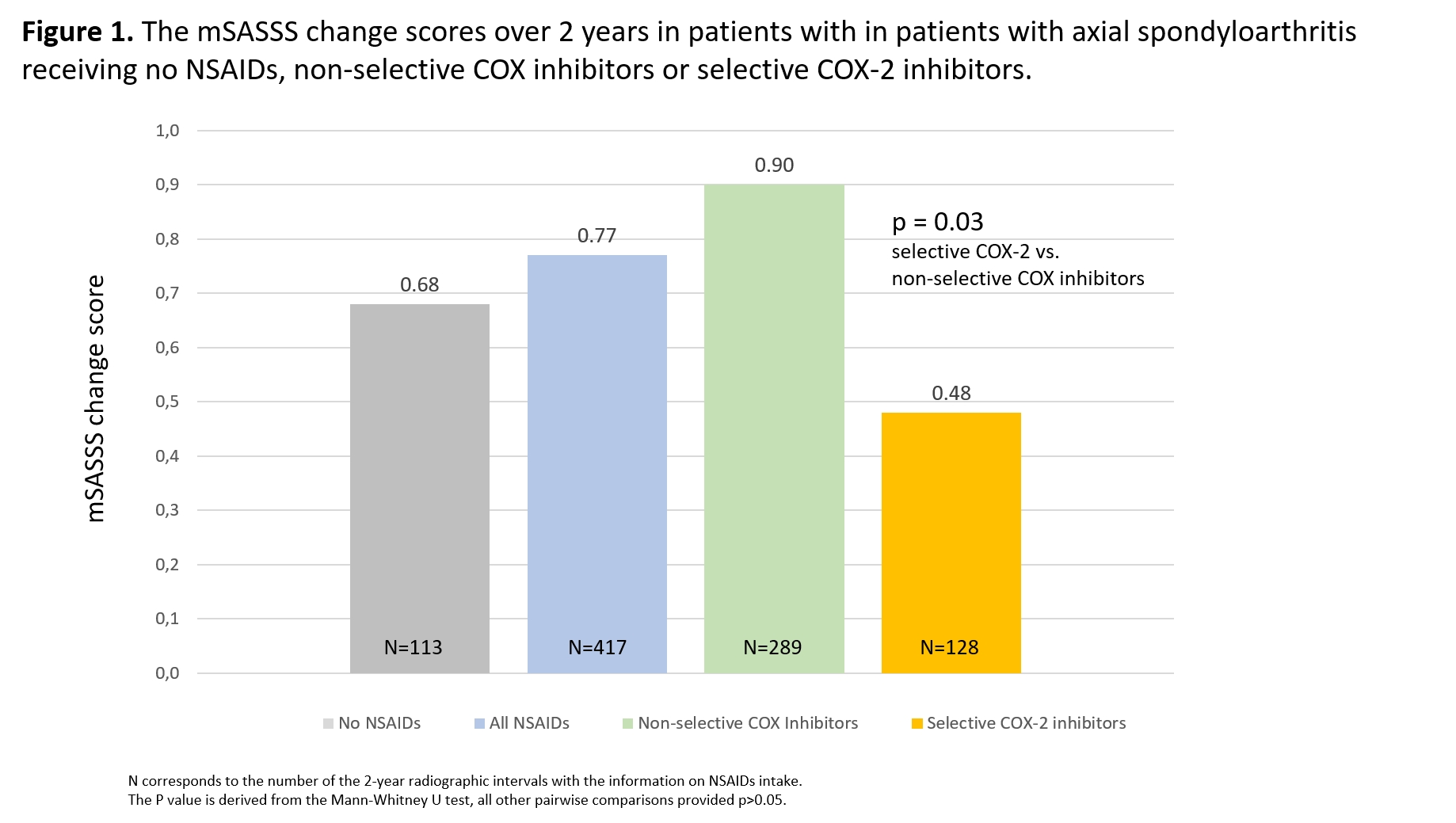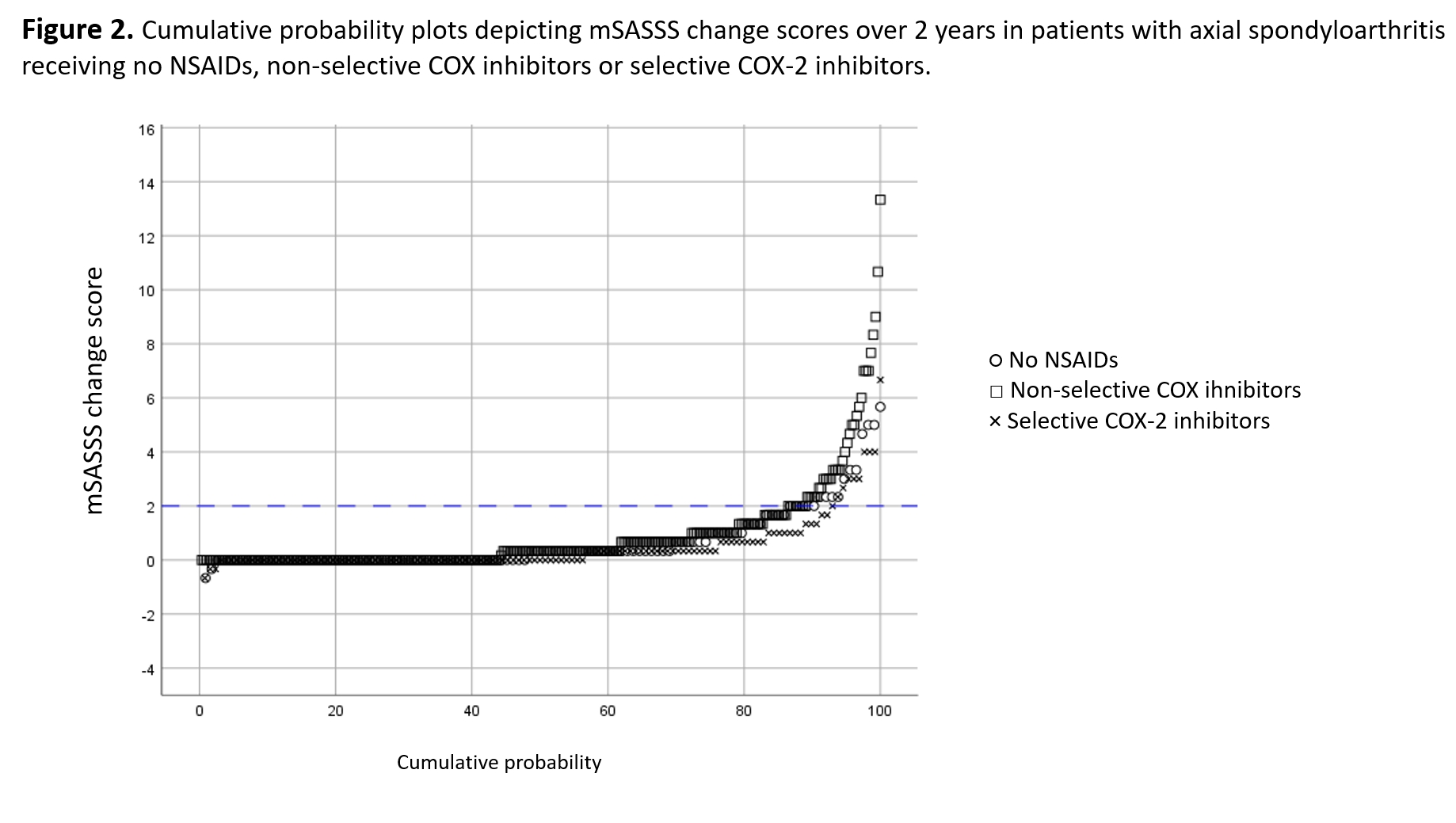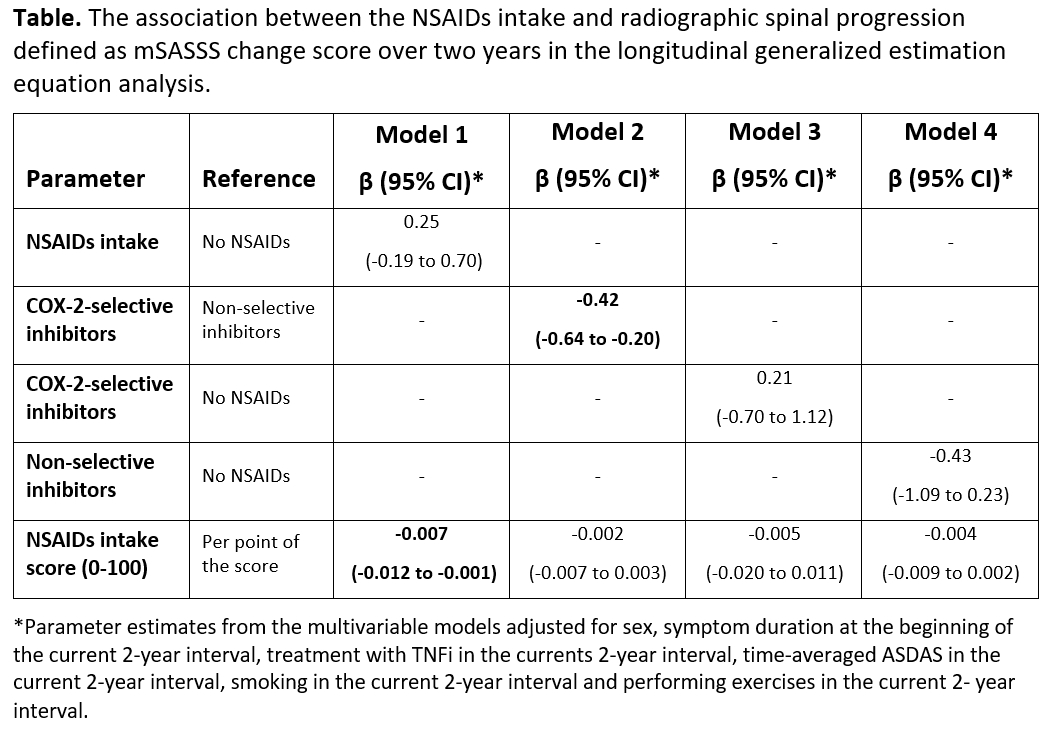Session Information
Date: Monday, November 9, 2020
Title: Spondyloarthritis Including Psoriatic Arthritis – Treatment III: Axial Spondyloarthritis (2028–2032)
Session Type: Abstract Session
Session Time: 4:00PM-4:50PM
Background/Purpose: There are conflicting data on the effect of non-steroidal anti-inflammatory drugs (NSAIDs) on radiographic spinal progression in axial spondyloarthritis (axSpA). One randomized controlled trial could show that continuous treatment with NSAIDs (mostly with a cyclooxygenase -2 – COX-2 – selective inhibitor celecoxib) was associated with inhibition of radiographic spinal progression, while another study showed no effect of continuous intake of the non-selective COX-inhibitor diclofenac on progression. In the analysis of the first 2 years of the German Spondyloarthritis Inception Cohort (GESPIC), higher NSAIDs intake was associated with retardation of radiographic progression, although it remained uncertain, whether COX-2-selective inhibitors have a stronger effect than non-selective ones.
The aim of the current analysis was to evaluate the effect of NSAIDs including non-selective and selective COX-2 inhibitors on radiographic spinal progression in patients with early axSpA in a long-term inception cohort.
Methods: A total of 266 patients with early axSpA (with r-axSpA with symptom duration ≤10 years and nr-axSpA with symptom duration ≤5 years) from the German Spondyloarthritis Inception Cohort (GESPIC) with at least two sets of spinal radiographs obtained at least 2 years apart during a 10-year follow-up were included. These patients contributed with a total of 542 2-year radiographic intervals. Spinal radiographs were evaluated by three trained and calibrated readers according to the modified Stoke Ankylosing Spondylitis Spine Score (mSASSS). The final mSASSS was calculated as a mean of three reader scores. NSAIDs intake (NSAIDs type, daily dosage and frequency of intake) was recorded at every visit. Coxibs (i.e., celecoxib, etoricoxib and rofecoxib) were considered selective COX-2 inhibitors, all other NSAIDs – as non-selective ones. The Assessment of Spondyloarthritis International Society (ASAS) NSAIDs intake score (0 – no NSAID intake, 100 – daily intake in the maximal anti-inflammatory dose dose) was calculated for 2-year intervals. The association between NSAIDs intake (NSAIDs type and NSAIDs score) and radiographic spinal progression defined as the absolute mSASSS change score over 2 years was analyzed using longitudinal generalized estimating equations (GEE) analysis.
Results: At baseline, 67% of the patients received NSAIDs. A total of 289 2-year radiographic intervals were covered by non-selective NSAIDs, 128 intervals with COX-2 selective ones, while 113 intervals were not covered by NSAIDs. Overall, the intake of COX-2 selective inhibitors was associated with lower radiographic spinal progression across all 2-year intervals as compared to non-selective NSAIDs (figure 1 and 2). In the longitudinal multivariable GEE analysis, intake of COX-2 selective inhibitors was associated with a lower mSASSS progression (as opposed to the treatment with non-selective NSAIDs) after adjustment for the NSAIDs intake score, treatment with tumor necrosis factor inhibitors and disease activity (table).
Conclusion: An inhibitory effect of NSAIDs on radiographic spinal progression in this axSpA cohort was attributable to the COX-2 selective inhibitors.
To cite this abstract in AMA style:
Poddubnyy D, Rios Rodriguez V, Torgutalp M, Dilbaryan A, Verba M, Protopopov M, Proft F, Rademacher J, Haibel H, Rudwaleit M, Sieper J. Treatment with Selective Cyclooxygenase-2 Inhibitors Is Associated with Inhibition of Radiographic Spinal Progression in Patients with Axial Spondyloarthritis: Long-term Results from the German Spondyloarthritis Inception Cohort [abstract]. Arthritis Rheumatol. 2020; 72 (suppl 10). https://acrabstracts.org/abstract/treatment-with-selective-cyclooxygenase-2-inhibitors-is-associated-with-inhibition-of-radiographic-spinal-progression-in-patients-with-axial-spondyloarthritis-long-term-results-from-the-german-spondy/. Accessed .« Back to ACR Convergence 2020
ACR Meeting Abstracts - https://acrabstracts.org/abstract/treatment-with-selective-cyclooxygenase-2-inhibitors-is-associated-with-inhibition-of-radiographic-spinal-progression-in-patients-with-axial-spondyloarthritis-long-term-results-from-the-german-spondy/



